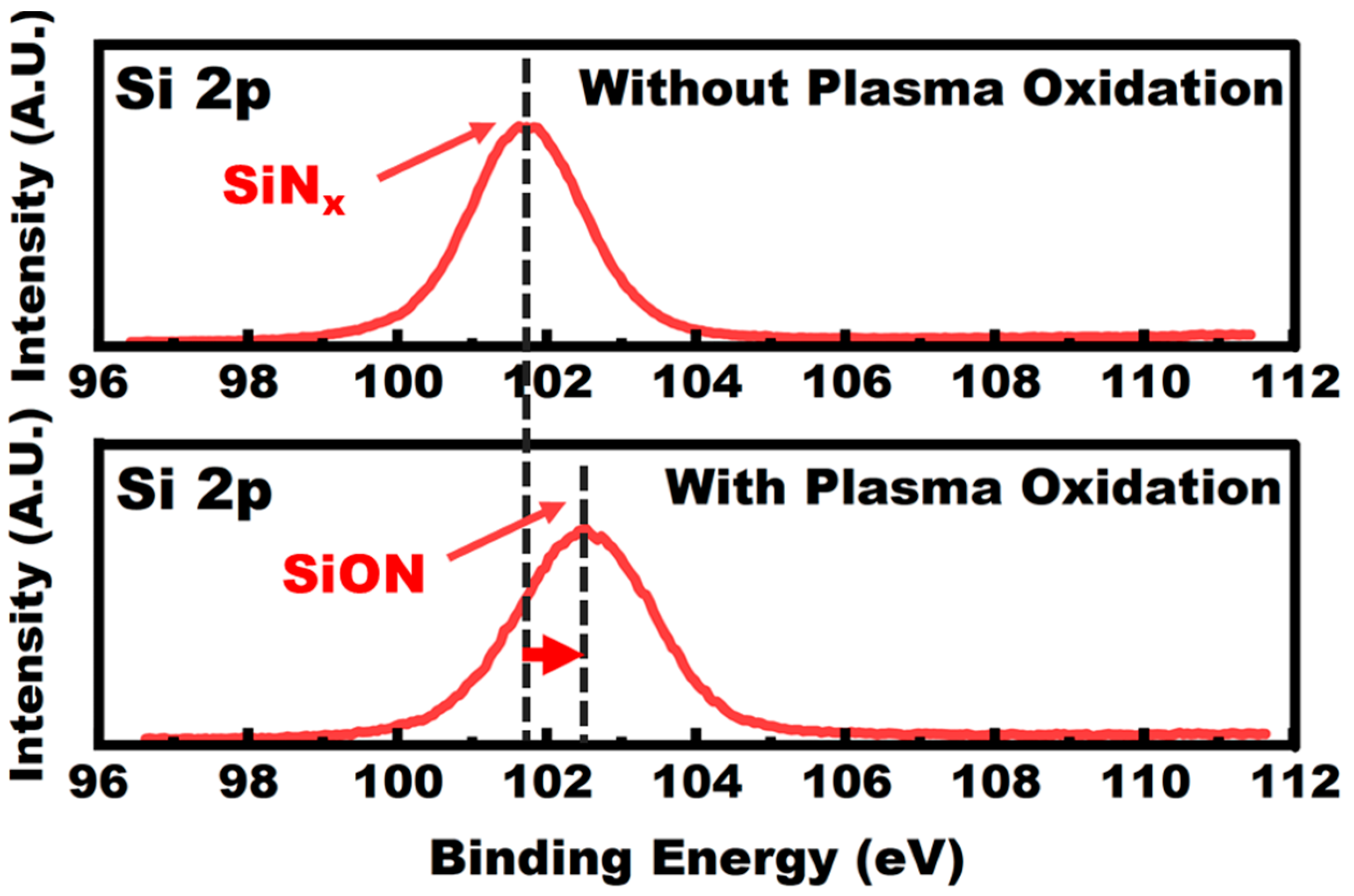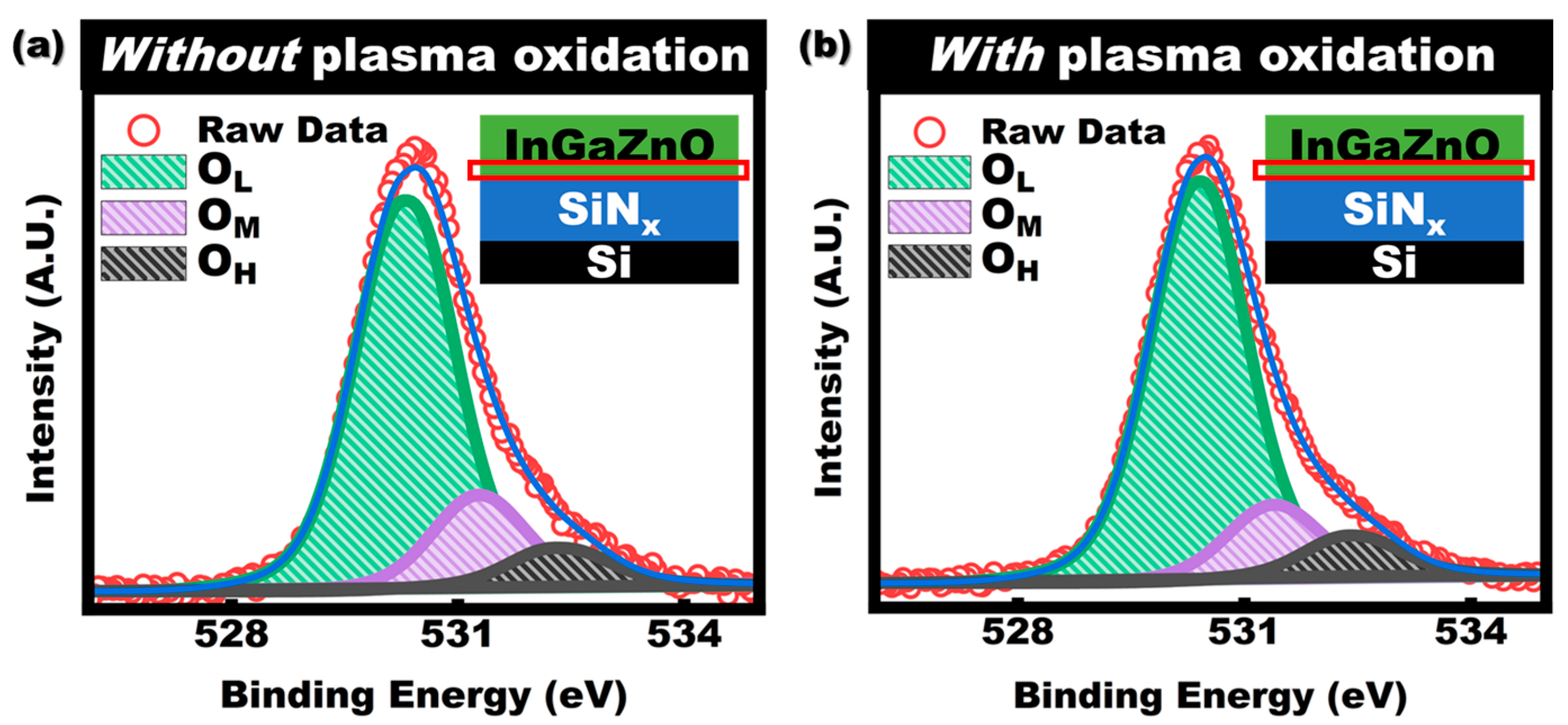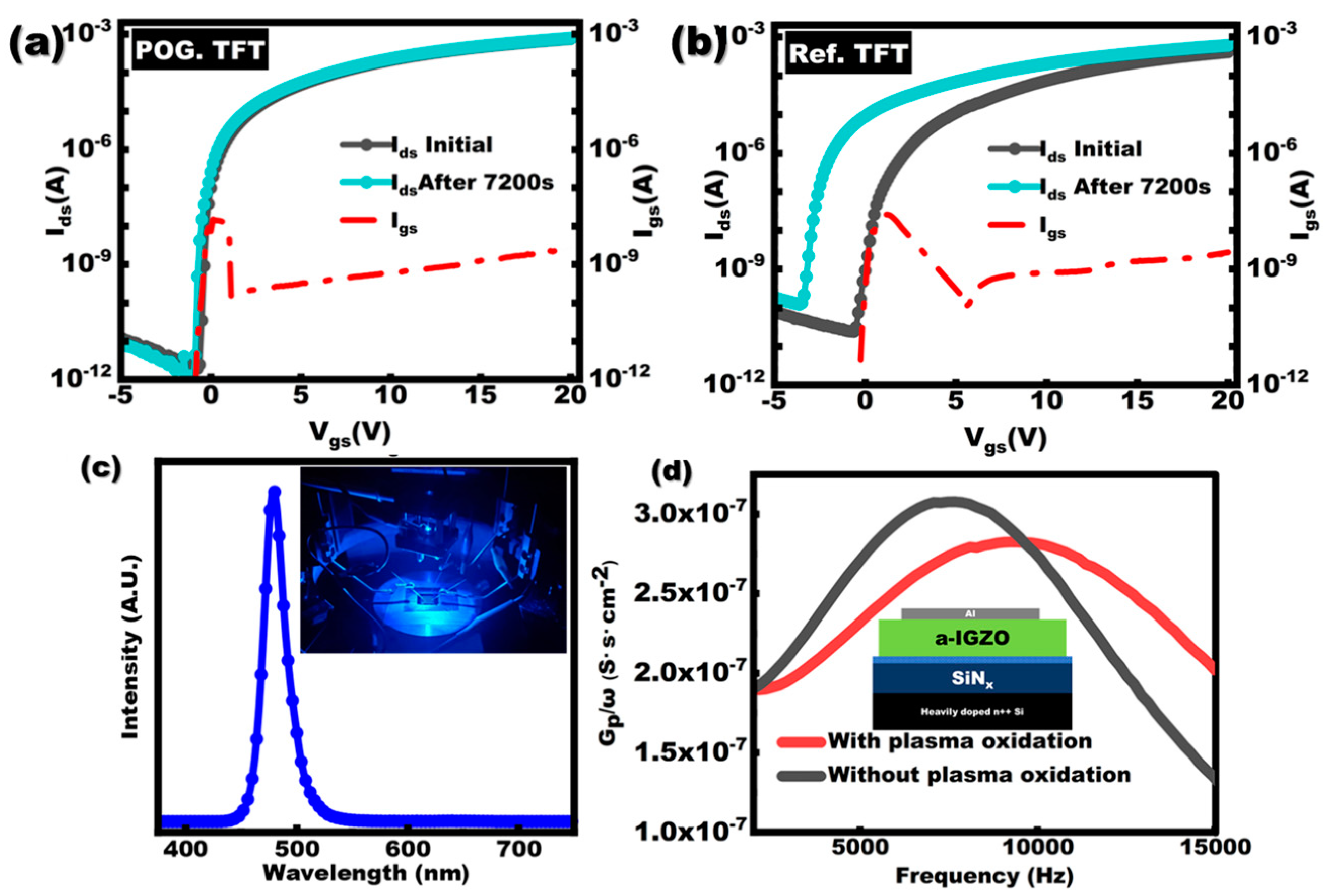Steep Subthreshold Swing and Enhanced Illumination Stability InGaZnO Thin-Film Transistor by Plasma Oxidation on Silicon Nitride Gate Dielectric
Abstract
:1. Introduction
2. Materials and Methods
3. Results
4. Conclusions
Author Contributions
Funding
Institutional Review Board Statement
Informed Consent Statement
Data Availability Statement
Acknowledgments
Conflicts of Interest
References
- Lee, J.S.; Chang, S.; Koo, S.-M.; Lee, S.Y. High-Performance InGaZnO TFT with ZrO2 Gate Dielectric Fabricated at Room Temperature. IEEE Electron Device Lett. 2010, 31, 225–227. [Google Scholar] [CrossRef]
- Jariwala, D.; Sangwan, V.K.; Seo, J.-W.T.; Xu, W.C.; Smith, J.; Kim, C.H.; Lauhon, L.J.; Marks, T.J.; Hersam, M.C. Large-Area, Low-Voltage, Antiambipolar Heterojunctions from Solution-Processed Semiconductors. Nano Lett. 2015, 15, 416–421. [Google Scholar] [CrossRef] [PubMed] [Green Version]
- Wang, Y.; Liu, S.W.; Sun, X.W.; Zhao, J.L.; Goh, G.K.L.; Vu, Q.V.; Yu, H.Y. Highly transparent solution processed In-Ga-Zn oxide thin films and thin film transistors. J. Sol.-Gel. Sci. Technol. 2010, 55, 322–327. [Google Scholar] [CrossRef]
- Nomura, K.; Ohta, H.; Takagi, A.; Kamiya, T.; Hirano, M.; Hosono, H. Room-temperature fabrication of transparent flexible thin-film transistors using amorphous oxide semiconductors. Nature 2004, 432, 488–492. [Google Scholar] [CrossRef] [PubMed]
- Yabuta, H.; Sano, M.; Abe, K.; Aiba, T.; Den, T.; Kumomi, H. High-mobility thin-film transistor with amorphous InGaZnO4 channel fabricated by room temperature rf-magnetron sputtering. Appl. Phys. Lett. 2006, 89, 112123. [Google Scholar] [CrossRef]
- Chiu, C.J.; Chang, S.P.; Chang, S.J. High-Performance InGaZnO Thin-Film Transistor Using Ta2O5 Gate Dielectric. IEEE Electron. Device Lett. 2010, 31, 1245–1247. [Google Scholar] [CrossRef]
- Hsu, H.H.; Chang, C.Y.; Cheng, C.H. A Flexible IGZO Thin-Film Transistor with Stacked TiO2-Based Dielectrics Fabricated at Room Temperature. IEEE Electron. Device Lett. 2013, 34, 768–770. [Google Scholar] [CrossRef]
- Zheng, L.L.; Qian, S.B.; Wang, Y.H.; Liu, W.J.; Ding, S.J. Mobility and Stability Enhancement of Amorphous In-Ga-Zn-O TFTs with Atomic Layer Deposited Al2O3/SiO2 Stacked Insulators. IEEE J. Electron. Device 2016, 4, 347–352. [Google Scholar] [CrossRef]
- Abliz, A.; Wang, J.L.; Xu, L.; Wan, D.; Liao, L.; Ye, C.; Liu, C.S.; Jiang, C.Z.; Chen, H.P.; Guo, T.L. Boost up the electrical performance of InGaZnO thin film transistors by inserting an ultrathin InGaZnO:H layer. Appl. Phys. Lett. 2016, 108, 213501. [Google Scholar] [CrossRef]
- Lin, C.I.; Fang, Y.K.; Chang, W.C.; Chiou, M.W.; Chen, C.W. Effect of gate barrier and channel buffer layer on electric properties and transparence of the InGaZnO thin film transistor. Microelectron. Reliab. 2014, 54, 905–910. [Google Scholar] [CrossRef]
- Januar, M.; Prakoso, S.P.; Lan, S.Y.; Mahanty, R.K.; Kuo, S.Y.; Liu, K.C. The role of oxygen plasma in the formation of oxygen defects in HfOx films deposited at room temperature. J. Mater. Chem. C 2015, 3, 4104–4114. [Google Scholar] [CrossRef]
- Pu, H.F.; Zhou, Q.F.; Yue, L.; Zhang, Q. Investigation of oxygen plasma treatment on the device performance of solution-processed InGaZnO thin film transistors. Appl. Surf. Sci. 2013, 283, 722–726. [Google Scholar] [CrossRef]
- Kamiya, T.; Nomura, K.; Hosono, H. Present status of amorphous In–Ga–Zn–O thin-film transistors. Sci. Technol. Adv. Mater. 2010, 11, 044305. [Google Scholar] [CrossRef] [PubMed]
- Cho, Y.J.; Shin, J.H.; Bobade, S.M.; Kim, Y.B.; Choi, D.K. Evaluation of Y2O3 gate insulators for InGaZnO thin film transistors. Thin Solid Film 2009, 517, 4115–4118. [Google Scholar] [CrossRef]
- Syamala Rao, M.G.; Sánchez-Martinez, A.; Gutiérrez-Heredia, G.; Quevedo- López, M.A.; Ramírez-Bon, R. Sol-gel derived low temperature HfO2-GPTMS hybrid gate dielectric for InGaZnO thin-film transistors (TFTs). Ceram. Int. 2018, 44, 16428–16434. [Google Scholar] [CrossRef]
- Zou, X.; Fang, G.J.; Yuan, L.Y.; Tong, X.S.; Zhao, X.Z. Improved electrical characteristics and reliability of amorphous InGaZnO metal–insulator–semiconductor capacitor with high k HfOxNy gate dielectric. Microelectron. Reliab. 2010, 50, 954–958. [Google Scholar] [CrossRef]
- Moon, Y.-K.; Lee, S.; Kim, W.-S.; Kang, B.-W.; Jeong, C.-O.; Lee, D.-H.; Park, J.-W. Improvement in the bias stability of amorphous indium gallium zinc oxide thin-film transistors using an O2 plasma-treated insulator. Appl. Phys. Lett. 2009, 95, 013507. [Google Scholar] [CrossRef]
- Yoo, H.; Tak, Y.J.; Kim, W.-G.; Kim, Y.-G.; Kim, H.J. A selectively processible instant glue passivation layer for indium gallium zinc oxide thin-film transistors fabricated at low temperature. J. Mater. Chem. C 2018, 6, 6187–6193. [Google Scholar] [CrossRef]
- Kang, J.H.; Cho, E.N.; Kim, C.E.; Lee, M.-J.; Lee, S.J.; Myoung, J.-M.; Yun, I. Mobility enhancement in amorphous InGaZnO thin-film transistors by Ar plasma treatment. Appl. Phys. Lett. 2013, 102, 222103. [Google Scholar] [CrossRef] [Green Version]
- Zhang, P.P.; Samanta, S.; Fong, X.Y. Physical Insights into the Mobility Enhancement in Amorphous InGaZnO Thin-Film Transistor by SiO2 Passivation Layer. IEEE Trans. Electron Device Lett. 2020, 67, 2352–2357. [Google Scholar] [CrossRef]
- Korner, W.; Urban, D.F.; Elsasser, C. Origin of subgap states in amorphous In-Ga-Zn-O. J. Appl. Phys. 2013, 114, 163704. [Google Scholar] [CrossRef]
- Noh, H.-K.; Chang, K.J.; Ryu, B.; Lee, W.-J. Electronic structure of oxygen-vacancy defects in amorphous In-Ga-Zn-O semiconductors. Phys. Rev. B 2011, 84, 115205. [Google Scholar] [CrossRef]
- Ryu, B.; Noh, H.-K.; Choi, E.-A.; Chang, K.J. O-vacancy as the origin of negative bias illumination stress instability in amorphous In–Ga–Zn–O thin film transistors. Appl. Phys. Lett. 2010, 97, 022108. [Google Scholar] [CrossRef] [Green Version]
- Kim, J.H.; Kim, U.K.; Chung, Y.J.; Hwang, C.S. Correlation of the change in transfer characteristics with the interfacial trap densities of amorphous In–Ga–Zn–O thin film transistors under light illumination. Appl. Phys. Lett. 2011, 98, 232102. [Google Scholar] [CrossRef]
- Nicollian, E.H.; Brews, J.R. MOS (Metal Oxide Semiconductor) Physics and Technology; Wiley: New York, NY, USA, 1982. [Google Scholar]
- Jeong, C.-Y.; Lee, D.; Song, S.-H.; Cho, I.-T.; Lee, J.-H.; Cho, E.-S.; Kwon, H.-I. Border trap characterization in amorphous indium-gallium-zinc oxide thin-film transistors with SiOx and SiNx gate dielectrics. Appl. Phys. Lett. 2013, 103, 142104. [Google Scholar] [CrossRef]
- Han, K.-L.; Ok, K.-C.; Cho, H.-S.; Oh, S.; Park, J.-S. Effect of hydrogen on the device performance and stability characteristics of amorphous InGaZnO thin-film transistors with a SiO2/SiNx/SiO2 buffer. Appl. Phys. Lett. 2017, 111, 063502. [Google Scholar] [CrossRef]
- Ok, K.-C.; Park, S.H.K.; Hwang, C.-S.; Kim, H.; Shin, H.S.; Bae, J.; Park, J.-S. The effects of buffer layers on the performance and stability of flexible InGaZnO thin film transistors on polyimide substrates. Appl. Phys. Lett. 2004, 104, 063508. [Google Scholar] [CrossRef]
- Wang, R.Z.; Wu, S.L.; Jia, D.B.; Wei, Q.; Zhang, J.T. Influence of different conditions on the electrical performance of amorphous InGaZnO thin-film transistors with HfO2/SiNx stacked dielectrics. J. Vac. Sci. Technol. B 2017, 35, 051204. [Google Scholar] [CrossRef]





| Device | Mobility (cm2/V·s) | Vth (V) | SS (mV/Decade) | Ion/Ioff |
|---|---|---|---|---|
| Ref. TFT | 10.64 | 1.95 | 312 | 1.68 × 107 |
| POG. TFT | 16.46 | −0.10 | 97 | 3.99 × 108 |
Publisher’s Note: MDPI stays neutral with regard to jurisdictional claims in published maps and institutional affiliations. |
© 2021 by the authors. Licensee MDPI, Basel, Switzerland. This article is an open access article distributed under the terms and conditions of the Creative Commons Attribution (CC BY) license (https://creativecommons.org/licenses/by/4.0/).
Share and Cite
Liu, Y.; Liu, C.; Qin, H.; Peng, C.; Lu, M.; Chen, Z.; Zhao, Y. Steep Subthreshold Swing and Enhanced Illumination Stability InGaZnO Thin-Film Transistor by Plasma Oxidation on Silicon Nitride Gate Dielectric. Membranes 2021, 11, 902. https://doi.org/10.3390/membranes11110902
Liu Y, Liu C, Qin H, Peng C, Lu M, Chen Z, Zhao Y. Steep Subthreshold Swing and Enhanced Illumination Stability InGaZnO Thin-Film Transistor by Plasma Oxidation on Silicon Nitride Gate Dielectric. Membranes. 2021; 11(11):902. https://doi.org/10.3390/membranes11110902
Chicago/Turabian StyleLiu, Yiming, Chang Liu, Houyun Qin, Chong Peng, Mingxin Lu, Zhanguo Chen, and Yi Zhao. 2021. "Steep Subthreshold Swing and Enhanced Illumination Stability InGaZnO Thin-Film Transistor by Plasma Oxidation on Silicon Nitride Gate Dielectric" Membranes 11, no. 11: 902. https://doi.org/10.3390/membranes11110902





